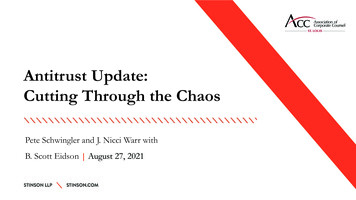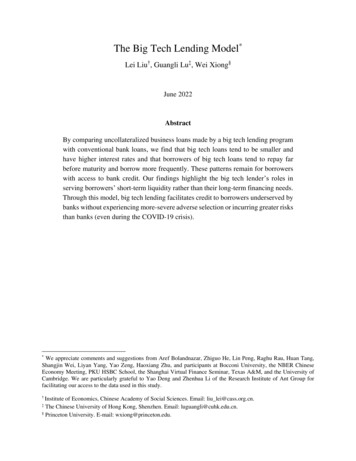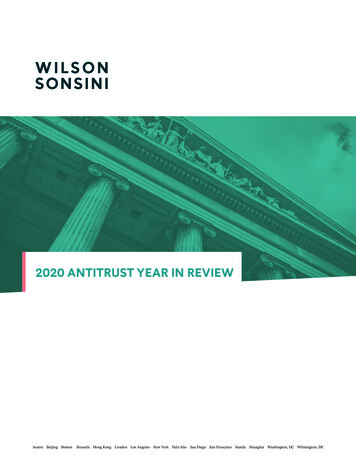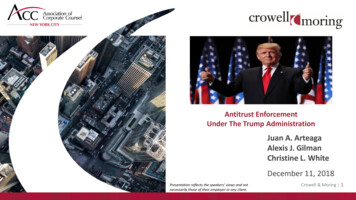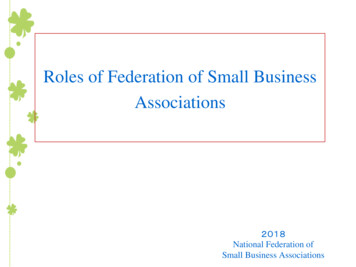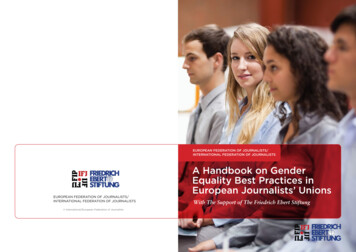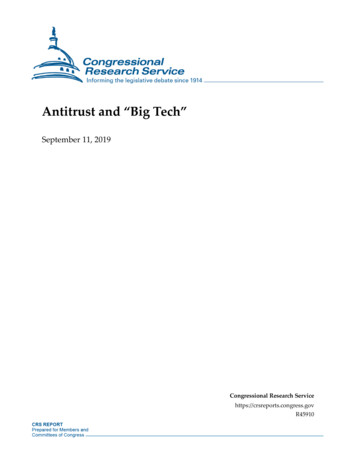
Transcription
Antitrust and “Big Tech”September 11, 2019Congressional Research Servicehttps://crsreports.congress.govR45910
SUMMARYAntitrust and “Big Tech”Over the past decade, Google, Amazon, Facebook, and Apple (“Big Tech” or the “Big Four”)have revolutionized the internet economy and affected the daily lives of billions of peopleworldwide. While these companies are responsible for momentous technological breakthroughsand massive wealth creation, they have also received scrutiny related to their privacy practices,dissemination of harmful content and misinformation, alleged political bias, and—as relevanthere—potentially anticompetitive conduct. In June 2019, the Wall Street Journal reported that theDepartment of Justice (DOJ) and Federal Trade Commission (FTC)—the agencies responsiblefor enforcing the federal antitrust laws—agreed to divide responsibility over investigations of theBig Four’s business practices. Under these agreements, the DOJ reportedly has authority overinvestigations of Google and Apple, while the FTC will look into Facebook and Amazon.R45910September 11, 2019Wilson C. FreemanLegislative AttorneyJay B. SykesLegislative AttorneyThe DOJ and FTC investigations into Big Tech will likely involve inquiries into whether the relevant companies haveillegally monopolized their respective markets or engaged in anticompetitive mergers or acquisitions. Under Section 2 of theSherman Act, it is illegal for a company with monopoly power to engage in exclusionary conduct to maintain or enhance thatpower. And under Section 7 of the Clayton Act, companies may not engage in mergers or acquisitions that “substantiallylessen” competition.The scope of the market in which a defendant-company operates is a key question in both monopolization and merger cases.The Supreme Court has identified certain qualitative factors that courts may consider in defining the scope of relevantantitrust markets. The DOJ and FTC have also adopted a quantitative market-definition inquiry known as the “hypotheticalmonopolist” or “SSNIP” test, according to which a relevant antitrust market consists of the smallest grouping of products forwhich a hypothetical monopolist could profitably impose a 5% price increase. The application of this quantitative inquiry tocertain zero-price technology markets may present courts and regulators with important issues of first impression. However,commentators have proposed a variety of methods by which regulators could assess the scope of the markets in which the BigFour operate.In addition to demonstrating that a defendant-company possesses monopoly power in a properly defined market,monopolization plaintiffs must show that the defendant engaged in exclusionary conduct to maintain or enhance that power.In investigating allegedly exclusionary behavior by the Big Four, antitrust regulators may be evaluating Google Search’s alleged discrimination against Google’s vertical rivals, certain tying and exclusive-dealingarrangements related to the company’s Android mobile operating system, and exclusive andrestrictive-dealing arrangements related to the company’s ad-brokering platform; Amazon’s alleged predatory pricing and discrimination against third-party merchants on its onlinemarketplace; Facebook’s allegedly anticompetitive pattern of acquiring promising potential competitors, including itsacquisitions of the photo-sharing service Instagram and the messaging service WhatsApp; and Apple’s decision to design its mobile-operating system to prevent customers from downloading iPhoneapps from any source other than the company’s App Store.While the antitrust action surrounding Big Tech is currently concentrated in the executive branch and the courts, digitalcompetition issues have also attracted the interest of Congress, which may pursue legislation to address anticompetitiveconduct by large technology companies. Specifically, some commentators have proposed that Congress adopt changes tocertain elements of antitrust law to promote competition in technology markets, including modifications to predatory-pricingdoctrine, exclusionary-design law, and merger review. In contrast, other commentators have advocated sector-specificcompetition regulation for large technology companies that would include data-portability rules, interoperability standards,nondiscrimination requirements, and separation regimes.Congressional Research Service
Antitrust and “Big Tech”ContentsLegal Background . 2General Principles . 2Section 2 of the Sherman Act: Monopolization . 3Monopoly Power. 4Exclusionary Conduct .11Section 7 of the Clayton Act: Mergers and Acquisitions . 18Antitrust and Big Tech: Possible Cases Against the Big Four . 19Google . 20Google Search: Refusals to Deal and Essential Facilities . 20Android: Tying and Exclusive Dealing . 23Google AdSense: Exclusive Dealing . 26Amazon . 27Facebook . 30Apple . 32Options for Congress . 33Changes to Antitrust Law . 33Sector-Specific Regulation . 35ContactsAuthor Information. 36Congressional Research Service
Antitrust and “Big Tech”ver the past decade, Google, Amazon, Facebook, and Apple—collectively known as the“Big Four” or “Big Tech”—have revolutionized the internet economy and affected thedaily lives of billions of people worldwide. Google operates a search engine thatprocesses over 3.5 billion searches a day (Google Search),1 runs the biggest online video platform(YouTube),2 licenses the world’s most popular mobile operating system (Android),3 and is thelargest seller of online advertising.4 Amazon is a major online marketplace, retailer, logisticsnetwork, cloud-storage host, and television and film producer.5 Facebook boasts 2.4 billionmonthly active users worldwide, meaning more people use the social network than follow anysingle world religion.6 Apple popularized the smartphone, making the device so ubiquitous thatconsumers have grown accustomed to carrying a supercomputer in their pocket.7 Collectively, theBig Four generated over 690 billion in revenue in 2018—a sum larger than the annual GDPs ofmost national economies.8OWhile these companies are responsible for momentous technological breakthroughs and massivewealth creation, they have also received scrutiny related to their privacy practices, disseminationof harmful content and misinformation, alleged political bias, and—as relevant here—potentiallyanticompetitive conduct.9 In June 2019, the Wall Street Journal reported that the Department ofJustice (DOJ) and Federal Trade Commission (FTC)—the agencies responsible for enforcing thefederal antitrust laws—agreed to divide responsibility over investigations of the Big Four’sbusiness practices. Under these agreements, the DOJ reportedly has authority over investigationsof Google and Apple, while the FTC will look into Facebook and Amazon.10 The followingmonth, the DOJ announced a potentially broader inquiry into Big Tech. Specifically, the JusticeDepartment’s Antitrust Division revealed that it intends to examine possible abuses of marketpower by unnamed “market-leading online platforms”11—an announcement that has led some to1Google Search Statistics, INTERNET LIVE STATS, tics/ (last accessedAug. 23, 2019).2 YouTube—Statistics & Facts, STATISTA (June 25, 2019), https://statista.com/topics/2019/youtube.3 Mobile Operating System Market Share Worldwide, July 2018-July 2019, STATCOUNTER, worldwide/.4 Jasmine Enberg, Digital Ad Spending 2019, Global, EMARKETER (Mar. 28, 2019), d-spending-2019.5 Paris Martineau & Louise Matsakis, Why It’s Hard to Escape Amazon’s Long Reach, WIRED (Dec. 23, pe-amazons-long-reach/.6 Number of Monthly Active Facebook Users Worldwide as of 2nd Quarter 2019, STATISTA, onthly-active-facebook-users-worlwide/ (last accessed Aug. 23, 2019); The ChangingReligious Landscape, PEW RESEARCH CTR. (April 5, 2017), obal-religious-landscape/.7 See David Pierce & Lauren Goode, The Wired Guide to the iPhone, WIRED (Dec. 7, 2018), https://www.wired.com/story/guide-iphone/.8 See Leading Online Companies Ranked by Revenue from 2017 to 2018, STATISTA (July 22, net-companies-revenue/; Gross Domestic Product 2018, WORLD BANK GDP.pdf.9 Ryan Tracy, Tech Giants Draw Fire in Congress, WALL ST. J. (July 16, 2019), h-in-crosshairs-11563311754.10 Brent Kendall & John D. McKinnon, Congress, Enforcement Agencies Target Tech, WALL ST. J. (June 3, n-11559576731.11 Justice Department Reviewing the Practices of Market-Leading Online Platforms, DEP’T OF JUSTICE (July 23, atforms.Congressional Research Service1
Antitrust and “Big Tech”speculate that a number of the Big Four may face investigations from both agencies despite thepreviously reported agreements.12Big Tech’s business practices have also attracted congressional interest. In May 2019, the SenateJudiciary Committee held a hearing to investigate privacy and competition issues in the digitaladvertising industry.13 And in June and July, the House Judiciary Committee held two separatehearings examining the market power of online platforms.14This report provides an overview of antitrust issues involving the Big Four. The report beginswith a general outline of the aspects of antitrust doctrine that are most likely to play a central rolein the DOJ and FTC investigations—specifically, the case law surrounding monopolization andmergers. Next, the report discusses the application of this doctrine to each of the Big Four.Finally, the report concludes by examining policy options related to the promotion of digitalcompetition.Legal BackgroundGeneral PrinciplesContemporary antitrust doctrine reflects a commitment to the promotion of economiccompetition, which induces businesses to cut costs, improve their productivity, and innovate. 1512John D. McKinnon & James V. Grimaldi, Justice Department, FTC Skirmish Over Antitrust Turf, WALL ST. J. (Aug.5, 2019), c-skirmish-over-antitrust-turf-1156997402.13 Understanding the Digital Advertising Ecosystem and the Impact of Data Privacy and Competition Policy: HearingBefore the S. Judiciary Comm., 116th Cong. (2019), act-of-data-privacy-and-competition-policy.14 Online Platforms and Market Power, Part 1: The Free and Diverse Press: Hearing Before H. Judiciary Comm.Subcommittee on Antitrust, Commercial and Administrative Law, 116th Cong. (2019), iverse-press; Online Platforms and MarketPower, Part 2: Innovation and Entrepreneurship: Hearing Before H. Judiciary Comm. Subcommittee on Antitrust,Commercial and Administrative Law, 116th Cong. (2019), and-entrepreneurship.15 Ohio v. Am. Express Co., 138 S. Ct. 2274, 2290 (2018) (explaining that the “primary purpose” of antitrust law is topromote competition) (citation omitted); N.C. State Bd. Of Dental Examiners v. FTC, 135 S. Ct. 1101, 1110 (2015)(explaining that antitrust law embodies “fundamental national values of free enterprise and economic competition”)(citation omitted); HERBERT HOVENKAMP, FEDERAL ANTITRUST POLICY: THE LAW OF COMPETITION AND ITSPRACTICE § 1.1 (5th ed. 2016). While contemporary antitrust doctrine focuses on the promotion of economiccompetition, early and mid-20th century antitrust case law often reflected a concern with other goals, including theprotection of small businesses and preservation of political equality. See Thomas E. Kauper, Influence of ConservativeEconomic Analysis on the Development of the Law of Antitrust, in HOW THE CHICAGO SCHOOL OVERSHOT THE MARK:THE EFFECT OF CONSERVATIVE ECONOMIC ANALYSIS ON U.S. ANTITRUST 43 (Robert Pitofsky ed., 2008) (describing theSupreme Court’s early and mid-20th century antitrust doctrine as “highly interventionist, concerned as much (or more)with the well-being of small entrepreneurs as with efficiency”). Contemporary courts have largely rejected theproposition that antitrust doctrine should incorporate these inquiries and instead follow the lead of the so-calledChicago School of antitrust analysis, which instructs that the promotion of consumer welfare should be the sole purposeof antitrust law. See, e.g., Kirtsaeng v. John Wiley & Sons, Inc., 568 U.S. 519, 539, (2013) (“[T]he principal objectiveof antitrust policy is to maximize consumer welfare by encouraging firms to behave competitively.”) (quoting 1 P.AREEDA & H. HOVENKAMP, ANTITRUST LAW ¶ 100, p. 4 (3d ed. 2006); Leegin Creative Leather Prod., Inc. v. PSKS,Inc., 551 U.S. 877, 902 (2007) (overturning an antitrust precedent because it “hinder[ed] competition and consumerwelfare”); Brooke Grp. Ltd. v. Brown & Williamson Tobacco Corp., 509 U.S. 209, 221 (1993) (noting that the“traditional concern[s]” of the antitrust laws are “consumer welfare and price competition”); Energy ConversionDevices Liquidation Tr. v. Trina Solar Ltd., 833 F.3d 680, 685 (6th Cir. 2016) (“At their core, the antitrust laws are aconsumer welfare prescription.”); Fishman v. Estate of Wirtz, 807 F.2d 520, 535 (7th Cir. 1986) (“[T]he enhancementCongressional Research Service2
Antitrust and “Big Tech”These virtues of competition are often illustrated with the stylized hypothetical of a “perfectlycompetitive” market with homogenous products, a large number of well-informed buyers andsellers, low entry barriers, and low transaction costs. In such a market, businesses must price theirproducts at marginal cost to avoid losing their customers to competitors.16 However, real-worldmarkets almost always deviate from this textbook model of perfect competition. When one ormore of the structural conditions identified above is absent, individual firms may have marketpower—the ability to profitably raise their prices above competitive levels. At the extreme, amarket can be monopolized when a single firm possesses significant and durable market power.17According to standard justifications for antitrust law, the exercise of significant market powerharms consumers by requiring them to pay higher prices than they would pay in competitivemarkets, purchase less desirable substitutes, or go without certain goods and services altogether.Moreover, significant market power harms society as a whole by reducing output and eliminatingvalue that would have been enjoyed in a competitive market.18 Contemporary antitrust doctrine isfocused on preventing these harms by prohibiting exclusionary conduct by dominant firms andanticompetitive mergers and acquisitions.19 The following subsections discuss these prohibitionsin turn.Section 2 of the Sherman Act: MonopolizationSection 2 of the Sherman Antitrust Act of 1890 makes it unlawful to monopolize, attempt tomonopolize, or conspire to monopolize “any part of the trade or commerce among the severalStates, or with foreign nations.”20 However, the statute itself does not define what it means to“monopolize” trade or commerce, leaving the courts to fill out the meaning of that conceptthrough common law decisionmaking. Consistent with this approach, the Supreme Court’sinterpretation of Section 2 has evolved in response to changes in economic theory and businesspractice.21In its monopolization case law, the Court has made clear that the possession of monopoly powerand charging of monopoly prices do not by themselves constitute Section 2 violations. Instead,the Court has held that a company engages in monopolization if and only if it (1) possessesmonopoly power, and (2) engages in exclusionary conduct to achieve, maintain, or enhance thatpower.22of consumer welfare is an important policy—probably the paramount policy—informing the antitrust laws.”).16 HOVENKAMP, supra note 15 § 1.1.17 Id.18 Id.19 Federal antitrust law also prohibits various forms of anticompetitive agreements between firms. 15 U.S.C. § 1. Thisreport focuses on antitrust law’s treatment of monopolization and mergers because of their special relevance to BigTech companies.20 15 U.S.C. § 2. Although Section 2 creates three distinct offenses—monopolization, attempted monopolization, andconspiracy to monopolize—all three offenses turn on the same general concepts: monopoly power and exclusionaryconduct. See U.S. DEP’T OF JUSTICE, SINGLE-FIRM CONDUCT UNDER SECTION 2 OF THE SHERMAN ACT 1 (2008) (reportwithdrawn) [hereinafter “DOJ SECTION 2 REPORT”].21 See HOVENKAMP, supra note 15 § 2.2a (explaining that antitrust law “has always been closely tied to prevailingeconomic doctrine”).22 United States v. Grinnell Corp., 384 U.S. 563, 570-71 (1966). Section 2 is enforced by the Department of Justice, theFederal Trade Commission (pursuant to Section 5 of the Federal Trade Commission Act), state attorneys general, andprivate plaintiffs. See 15 U.S.C. §§ 4, 15a, 45; FTC v. Cement Institute, 333 U.S. 683, 694 (1948) (“[A]ll conductviolative of the Sherman Act may likewise come within the unfair trade practice prohibitions” of the Federal TradeCongressional Research Service3
Antitrust and “Big Tech”Elements of a Monopolization ClaimTo prevail in a Section 2 monopolization case, plaintiffs must show that the defendant(1) possesses monopoly power, and(2) engages in exclusionary conduct to achieve, maintain, or enhance that power.Monopoly PowerTo prevail in a Section 2 case, plaintiffs must show that a defendant possesses monopoly power.While the Supreme Court has explained that a firm has market power if it can profitably chargesupra-competitive prices,23 the Court has described monopoly power as “the power to controlprices or exclude competition,”24 which requires “something greater” than market power.25 Lowerfederal courts have held that a firm possesses monopoly power if it possesses a high degree ofmarket power.26A Section 2 plaintiff can establish that a defendant possesses monopoly power in two ways. First,plaintiffs can satisfy this requirement with direct evidence of monopoly power—that is, evidencethat the defendant charges prices significantly exceeding competitive levels.27 However, suchevidence is typically difficult to adduce because of complications in determining appropriatemeasures of a firm’s costs, among other things.28 As a result, plaintiffs generally attempt toestablish that a defendant has monopoly power with indirect evidence showing that the defendant(1) possesses a large share of a relevant market, and (2) is protected by entry barriers.29Commission Act); HOVENKAMP, supra note 15 § 16.23 NCAA v. Bd. of Regents of the Univ. of Okla., 468 U.S. 85, 109 n.38 (1984); Jefferson Parish Hosp. Dist. No. 2 v.Hyde, 466 U.S. 2, 27 n.46 (1984).24 United States v. E.I. du Pont de Nemours & Co., 351 U.S. 377, 391 (1956).25 Eastman Kodak Co. v. Imagine Technical Servs., Inc., 504 U.S. 451, 481 (1992).26 See, e.g., Bacchus Indus., Inc. v. Arvin Indus., Inc., 939 F.2d 887, 894 (10th Cir. 1991) (explaining that a firmpossesses monopoly power if it has “substantial” market power); Deauville Corp. v. Federated Dep’t Stores, Inc., 756F.2d 1183, 1192 n.5 (5th Cir. 1985) (explaining that a firm possesses monopoly power if it has an “extreme degree” ofmarket power).27 See Geneva Pharm. Tech. Corp. v. Barr Lab. Inc., 386 F.3d 485, 500 (2d Cir. 2004); United States v. Microsoft, 253F.3d 34, 51 (D.C. Cir. 2001); Re/Max Intern., Inc. v. Realty One, Inc., 173 F.3d 995, 1016 (6th Cir. 1999); CoastalFuels of Puerto Rico, Inc. v. Caribbean Petroleum Corp., 79 F.3d 182, 196-97 (1st Cir. 1996); Rebel Oil Co., Inc. v.Atlantic Richfield Co., 51 F.3d 1421, 1434 (9th Cir. 1995); but see Christy Sports, LLC v. Deer Valley Resort Co., 555F.3d 1188, 1198 (10th Cir. 2009) (noting that the Tenth Circuit has never explicitly accepted or rejected the propositionthat monopoly power can be proved directly in a Section 2 case).28 See Louis Kaplow, Why (Ever) Define Markets?, 124 HARV. L. REV. 437, 447 (2010). See also McWane, Inc. v.FTC, 783 F.3d 814, 830 (11th Cir. 2015) (“Because . . . direct proof [of monopoly power] is only rarely available,courts more typically examine market structure in search of circumstantial evidence of monopoly power.”) (quotingUnited States v. Microsoft Corp., 253 F.3d 34, 51 (D.C. Cir. 2001); Bailey v. Allgas, Inc., 284 F.3d 1237, 1246 (11thCir. 2002) (“Because demand is difficult to establish with accuracy, evidence of a seller’s market share may provide themost convenient circumstantial measure of monopoly power.”).29 See McWane, Inc., 783 F.3d at 830; Broadcom Corp. v. Qualcomm Inc., 501 F.3d 297, 307 (3d Cir. 2007); Microsoft,253 F.3d at 51; Toys ‘R’ Us, Inc. v. FTC, 221 F.3d 928, 937 (7th Cir. 2000); Re/Max Intern., Inc., 173 F.3d at 1016; W.Parcel Express v. UPS, 190 F.3d 974, 975 (9th Cir. 1999); Am. Council of Certified Podiatric Physicians & Surgeons v.Am. Bd. of Podiatric Surgery, Inc., 185 F.3d 606, 622-23 (6th Cir. 1999); Rebel Oil Co., 51 F.3d at 1434; Ryko Mfg.Co. v. Eden Servs., 823 F.2d 1215, 1232 (8th Cir. 1987).Congressional Research Service4
Antitrust and “Big Tech”Market ShareTo demonstrate that a defendant possesses a dominant market share, plaintiffs must define thescope of the market in which the defendant operates. Predictably, antitrust plaintiffs typicallyargue that a defendant operates in a narrow market with few competitors, while defendantsordinarily contend that they operate in a broad market with many rivals. Because the size of themarket in which a defendant operates (the denominator in a market-share calculation) is generallyharder to determine than its sales or revenue (the numerator in such a calculation), parties inantitrust litigation often vigorously contest the issue of market definition—so much, in fact, thatmore antitrust cases hinge on that question than on “any other substantive issue” in competitionlaw.30Market Definition: Substitutability and the SSNIP Test. In analyzing market definition, theSupreme Court has explained that a relevant antitrust market consists of the product at issue in agiven case and all other products that are “reasonably interchangeable” with it.31 According to theCourt, whether one product is “reasonably interchangeable” with another product depends ondemand substitution—that is, the extent to which an increase in one product’s price would causeconsumers to purchase the other product instead.32 The Court has further explained that a varietyof “practical indicia” are relevant to an assessment of whether goods and services are reasonablesubstitutes, including1.2.3.4.5.6.7.industry or public recognition of separate markets;a product’s peculiar characteristics and uses;unique production facilities;distinct customers;distinct prices;sensitivity to price changes; andspecialized vendors.These criteria are sometimes called the “Brown Shoe” factors based on the name of the 1962decision in which the Court identified them.33In addition to the Brown Shoe factors, the DOJ and FTC have provided specific market-definitionguidance in their Horizontal Merger Guidelines. The 2010 version of the Guidelines endorses the“hypothetical monopolist” test for defining markets, which—like the Court’s case law—principally focuses on demand substitution.34 Under this test, a group of products qualifies as arelevant antitrust market if a hypothetical monopolist selling those products would find itprofitable to raise their price notwithstanding buyers’ incentives to substitute other goods andservices in response. Specifically, the test asks whether a hypothetical monopolist would be ableto profitably impose a “small but significant and non-transitory increase in price” (SSNIP)—generally, a 5% increase.35 If buyer substitution to other products would make such a price30Jonathan Baker, Market Definition: An Analytical Overview, 74 ANTITRUST L.J. 129, 129 (2007).Brown Shoe Co. v. United States, 370 U.S. 294, 325 (1962).32 Id.33 Id.34 U.S. DEP’T OF JUSTICE & FED. TRADE COMM’N, HORIZONTAL MERGERS GUIDELINES § 4 (2010) [hereinafter “2010HORIZONTAL MERGER GUIDELINES”].35 Id.31Congressional Research Service5
Antitrust and “Big Tech”increase unprofitable, then the candidate market must be expanded until a hypotheticalmonopolist would benefit from such a strategy.36One popular antitrust treatise illustrates the SSNIP test’s application by comparing proposedmarkets consisting of Ford passenger cars and all passenger cars. Because Ford—which has a“monopoly” over the sale of Ford passenger cars—would likely be unable to profitably raise itsprices by 5% because of the business it would lose to other car companies, Ford passenger carsare unlikely to qualify as a properly defined antitrust market. However, because a hypotheticalfirm with a monopoly over passenger cars likely could profit from such a price increase,passenger cars likely qualify as a distinct antitrust market.37Market Definition and Big Tech: The Challenge of Zero-Price Markets. The SSNIP test’sapplication to certain technology markets raises difficult issues. In a number of technologymarkets, firms do not charge customers for access to certain services like online search and socialnetworking. The difficulty with applying the SSNIP test to such markets is clear: as onecommentator notes, there is “no sound way” to analyze a 5% increase in a price of zero becausesuch an increase would result in a price that remains zero.38 The SSNIP test as traditionallyadministered is accordingly “inoperable” in a number of zero-price technology markets.39Some courts and commentators have responded to this difficulty in applying the SSNIP test tozero-price markets by concluding that such markets are categorically exempt from antitrustscrutiny. In Kinderstart.com, LLC v. Google, Inc., for example, a federal district court dismissedallegations that Google monopolized the market for online search on the grounds that Googledoes not charge customers to use its search engine.40 Several commentators have echoed thegeneral line of reasoning behind the Kinderstart decision and questioned whether the provision offree services can result in the type of consumer harm that antitrust law is intended to remedy.4136A number of courts have also accepted the SSNIP test as an appropriate method for defining relevant antitrustmarkets. See FTC v. Whole Foods Mkt., Inc., 548 F.3d 1028, 1038 (D.C. Cir. 2008) (“If a small price increase woulddrive consumers to an alternative product, then that product must be reasonably substitutable for those in the proposedmarket and must therefore be part of the market, properly defined.”); Theme Promotions, Inc. v. News Am. Mktg. FSI,546 F.3d 991, 1002 (9th Cir. 2008) (“If a monopolist could not profitably impose a SSNIP, the market definition shouldbe expanded to include those substitute products that constrain the monopolist’s pricing.”); United States v. EngelhardCorp., 126 F.3d 1302, 1306 (11th Cir. 1997) (“First, when determining the relevant market, the question is whether ahypothetical monopolist could profitably raise price.”).37 See HOVENKAMP, supra note 15 § 3.2.38 David S. Evans, The Antitrust Economics of Free, 7 COMPETITION POL’Y INT’L 71, 72 (2011).39 Id.; see also Assistant Att’y Gen. Makan Delrahim, “I’m Free”: Platforms and Antitrust Enforcement in the ZeroPrice Economy, Address at Silicon Flatirons Annual Tech. Policy Conference at the Univ. of Co. L. Sch. (Feb. 11,2019), ssilicon-flatirons (explaining that the SSNIP test “does not translate directly to
Big Tech's business practices have also attracted congressional interest. In May 2019, the Senate Judiciary Committee held a hearing to investigate privacy and competition issues in the digital advertising industry.13 And in June and July, the House Judiciary Committee held two separate hearings examining the market power of online platforms.14
